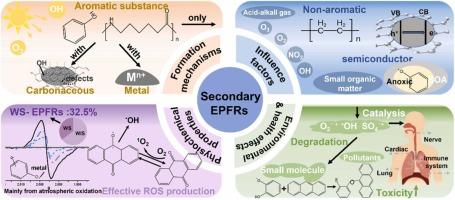A critical review of secondary environmentally persistent free radicals: formation, properties, environmental and health impacts
IF 11.3
1区 环境科学与生态学
Q1 ENGINEERING, ENVIRONMENTAL
引用次数: 0
Abstract
Environmentally persistent free radicals (EPFRs) are a class of emerging organic pollutants widely present in various environmental media. They may pose health risks through the generation of reactive oxygen species (ROS). Although previous studies have focused on primary EPFRs generated directly from thermal reactions, research on secondary EPFRs generated through atmospheric oxidation and metal catalysis remains fragmented and lacks a systematic review. To fill this research gap, this review presents the first comprehensive and systematic overview of secondary EPFRs, summarizing the formation mechanisms of secondary EPFRs, key influencing factors, physicochemical properties, and their environmental and health impacts. Our findings revealed that photooxidation plays a dominant role in secondary EPFR formation. Meanwhile, we found that in addition to aromatic compounds as precursors, non-aromatic compounds such as polyethylene, polyamide, and ceftriaxone sodium can also generate secondary EPFRs under certain environmental conditions, expanding the scope of potential precursors. Moreover, we revealed that secondary EPFRs may exhibit distinct physicochemical properties compared to primary EPFRs, including higher water solubility and greater efficiency in ROS production. These differences may significantly influence their environmental fate, toxicity, and impact on human health. Finally, by synthesizing the key findings in secondary EPFR research, we provide a prospective outlook on the future research directions of secondary EPFRs.

二次环境持久性自由基的形成、性质、环境和健康影响综述
环境持久性自由基(environmental persistent free radicals, epfr)是一类广泛存在于各种环境介质中的新兴有机污染物。它们可能通过产生活性氧(ROS)对健康构成威胁。虽然以往的研究主要集中在热反应直接生成的初级EPFRs,但对大气氧化和金属催化生成的次级EPFRs的研究仍然是零散的,缺乏系统的综述。为了填补这一研究空白,本文首次对次生EPFRs进行了全面系统的综述,综述了次生EPFRs的形成机制、关键影响因素、理化性质及其对环境和健康的影响。我们的研究结果表明,光氧化在次生EPFR形成中起主导作用。同时,我们发现除了芳香族化合物作为前体外,聚乙烯、聚酰胺、头孢曲松钠等非芳香族化合物在一定的环境条件下也能生成次生epfr,扩大了潜在前体的范围。此外,我们发现,与初级EPFRs相比,二级EPFRs可能具有不同的物理化学性质,包括更高的水溶性和更高的ROS生成效率。这些差异可能显著影响它们的环境命运、毒性和对人类健康的影响。最后,通过对次生EPFR研究的主要发现进行综合,对未来次生EPFR的研究方向进行了展望。
本文章由计算机程序翻译,如有差异,请以英文原文为准。
求助全文
约1分钟内获得全文
求助全文
来源期刊

Journal of Hazardous Materials
工程技术-工程:环境
CiteScore
25.40
自引率
5.90%
发文量
3059
审稿时长
58 days
期刊介绍:
The Journal of Hazardous Materials serves as a global platform for promoting cutting-edge research in the field of Environmental Science and Engineering. Our publication features a wide range of articles, including full-length research papers, review articles, and perspectives, with the aim of enhancing our understanding of the dangers and risks associated with various materials concerning public health and the environment. It is important to note that the term "environmental contaminants" refers specifically to substances that pose hazardous effects through contamination, while excluding those that do not have such impacts on the environment or human health. Moreover, we emphasize the distinction between wastes and hazardous materials in order to provide further clarity on the scope of the journal. We have a keen interest in exploring specific compounds and microbial agents that have adverse effects on the environment.
 求助内容:
求助内容: 应助结果提醒方式:
应助结果提醒方式:


